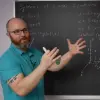

NARROW DISPLAY WARNING
You are most likely using a tablet or mobile device in portrait orientation. This website is best viewed using a typical computer screen with the browser window maximized.
Viewing this website in portrait orientation can cause problems with equations being longer than the screen width (you can scroll to the right), images being poorly sized, and the font size of maths text being much smaller than regular text. If your only option is a tablet or mobile device, your viewing experience will be better if you view this website in landscape orientation. You might need to refresh the page to fix any problems after rotating.
A differential equation is an equation that has an unknown function and its derivatives present. The simplest example is $y'(x) = y(x)$ with $y(x)$ an unknown function.
A non-example is $y'(x) = x$ which is not usually considered a differential equation since $y(x)$ is not present.
An ODE is a differential equation where the unknown function is a function of a single variable, like $y(x)$.
A PDE is a differential equation where the unknown function is a function of a multiple variables, like $f(x,y)$ or $f(x,y,z)$. An example is the temperature at every point $(x,y)$ on a flat metal plate or the density of air at every point $(x,y,z)$ in a music hall.
There's three common ways to write derivatives of a single variable function $y(x)$. Which one to use is personal preference, but people usually pick the one that requires the least writing and is easiest to read.
\begin{equation} \frac{\text{d}y}{\text{d}x} = y' = y^{(1)} \qquad\qquad \frac{\text{d}^{2}y}{\text{d}x^{2}} = y'' = y^{(2)} \qquad\qquad \frac{\text{d}^{5}y}{\text{d}x^{5}} = y''''' = y^{(5)} \end{equation}A fourth way to write derivatives of a single variable function $u(t)$ is with the "dot notation" common in physics and engineering.
\begin{equation} \frac{\text{d}u}{\text{d}t} = u' = u^{(1)} = \dot{u} \qquad\qquad \frac{\text{d}^{2}u}{\text{d}t^{2}} = u'' = u^{(2)} = \ddot{u} \end{equation}This notation is used for functions of time $t$ and you typically only see a single "u dot" or a "u double dot" since first and second time derivatives are common in physics and engineering. A differential equation with a "u triple dot" is uncommon.
There's two common ways to write partial derivatives for a function $f(x,y)$. (Note: The order on the mixed partial changes between the two notations.)
\begin{equation} \frac{\partial f}{\partial x} = f_{x} \qquad \qquad \frac{\partial^{2} f}{\partial x^{2}} = f_{xx} \qquad\qquad \frac{\partial f}{\partial y} = f_{y} \qquad \qquad \frac{\partial^{2} f}{\partial y^{2}} = f_{yy} \end{equation} \begin{equation} \frac{\partial }{\partial y}\frac{\partial }{\partial x} f = \frac{\partial^{2} f}{\partial y \partial x} = f_{xy} \qquad\qquad \frac{\partial }{\partial x}\frac{\partial }{\partial y} f = \frac{\partial^{2} f}{\partial x \partial y} = f_{yx} \end{equation}The order of a differential equation is the highest derivative of the unknown function present.
\begin{align} y'' + y = 1 & \quad\text{2nd order} \\ \\ (y')^{5} + y = 1 & \quad\text{1st order} \\ \\ y'''y''y'y = x & \quad\text{3rd order} \\ \\ \sin(y^{(4)}) + y = e^{x} & \quad\text{4th order} \\ \\ \end{align}A linear differential equation has the following form.
\begin{equation} p_{n}(x)y^{(n)} + p_{n-1}(x)y^{(n-1)} + \cdots + p_{1}(x)y' + p_{-}(x)y = g(x) \end{equation}The functions of $x$ do not matter for the differential equation to be linear or nonlinear. The only thing that matters is the $y(x)$ function and all its derivatives multiply a function of $x$. A differential equation is nonlinear means the differential equation does not fit the form of a linear differential equation.
\begin{align} y'' + y = 1 & \quad\text{linear} \\ \\ \tan\left(\frac{\ln(x)}{x^{2}+1}\right) y'' + x^{x} y = e^{\sin(x)} & \quad\text{linear} \\ \\ (y')^{2} + y = 7 & \quad\text{nonlinear} \\ \\ y''y' + y' + xy = 31 & \quad\text{nonlinear} \\ \\ y^{(5)} + \frac{1}{y} = e^{x} & \quad\text{nonlinear} \\ \\ y'' + \sin(y') + y = \frac{1}{x} & \quad\text{nonlinear} \\ \\ y'' + e^{y} = 4 & \quad\text{nonlinear} \\ \\ \ln(y') + y = 0 & \quad\text{nonlinear} \\ \end{align}An explicit solution to an ODE is $y(x)=f(x)$. Ideally, we want to solve for $y$ in terms of $x$, but that is not always possible.
For example, there is no way to solve for $y$ in the following equation.
\begin{equation} y^{2} + e^{y} = \sin(x) + C\ln(x) \end{equation}This is an implicit general solution for $x$ and $y$.